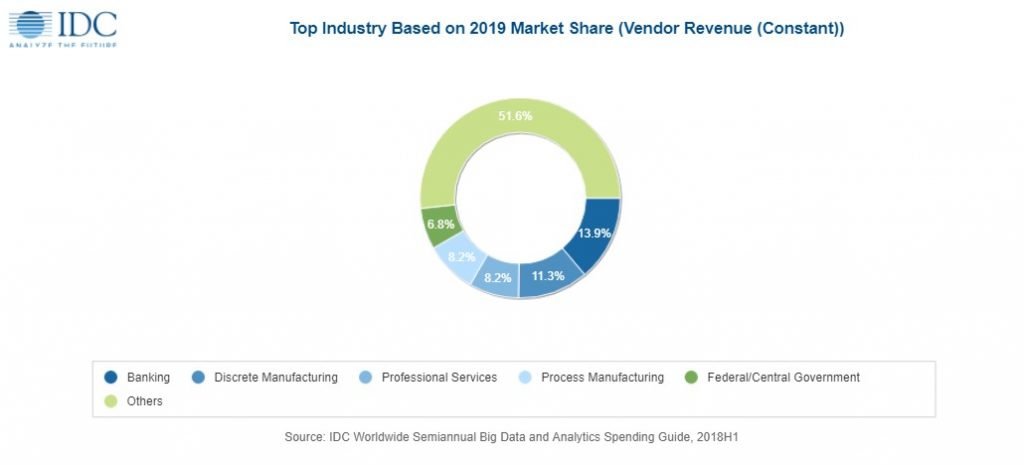Big data and business analytics (BDA) solutions are set to reach new high. According to IDC Forecast, Global revenues for big data and business analytics solutions are forecast to reach $189.1 billion this year, an increase of 12.0% over 2018. Big data and business analytic report also shows that BDA revenues will maintain this pace of growth throughout the 2018-2022.
IT services will be the largest category of the Big data and business analytics market in 2019 ($77.5 billion), followed by hardware purchases ($23.7 billion), and business services ($20.7 billion). Together, IT and business services will account for more than half of all BDA revenues throughout the forecast and will be among the categories with the fastest growth. BDA-related software revenues will be $67.2 billion in 2019, with end-user query, reporting, and analysis tools ($13.6 billion) and relational data warehouse management tools ($12.1 billion) being the two largest software categories.
The Big data and business analytics technology categories that will see the fastest revenue growth will be non-relational analytic data stores (34.0% CAGR) and cognitive/AI software platforms (31.4% CAGR).
In terms of deployment, more than 70% of Big data and business analytics software revenues in 2019 will go toward on-premises solutions. However, revenue for Big data and business analytics software delivered via the public cloud will experience very strong growth over the five-year forecast (32.3% CAGR) and will represent more than 44% of the total BDA software opportunity in 2022.
“Big Data technologies can be difficult to deploy and manage in a traditional, on premise environment. Add to that the exponential growth of data and the complexity and cost of scaling these solutions, and one can envision the organizational challenges and headaches. However, cloud can help mitigate some of these hurdles. Cloud’s promise of agility, scale, and flexibility combined with the incredible insights powered by BDA delivers a one-two punch of business benefits, which are helping to accelerate BDA adoption,” said Jessica Goepfert, program vice president, Customer Insights & Analysis at IDC. “When we look at the opportunity trends for BDA in the cloud, the top three industries for adoption are professional services, personal and consumer services, and media. All three industries are rife with disruption and have high levels of digitization potential. Additionally, we often find many smaller, innovative firms in this space; firms that appreciate the access to technologies that may have historically been out of reach to them either due to cost or IT complexity.”
The industries currently making the largest investments in big data and business analytics solutions are banking, discrete manufacturing, professional services, process manufacturing, and federal/central government. Combined, these five industries will account for nearly half ($91.4 billion) of worldwide BDA revenues this year. The industries that will deliver the fastest BDA growth are securities and investment services (15.3% CAGR) and retail (15.2% CAGR). Retail’s strong growth will enable it to move ahead of federal/central government as the fifth largest industry in 2022.

On a geographic basis, the United States will be the largest country market by a wide margin with nearly $100 billion in Big data and business analytics revenues this year. Japan and the UK will generate revenues of $9.6 billion and $9.2 billion respectively this year, followed by China ($8.6 billion) and Germany ($7.9 billion). The fastest growth in the BDA market will be in Argentina and Vietnam with five-year CAGRs of 23.1% and 19.4%, respectively. China will have the third fastest growth rate with a 19.2% CAGR, which will enable it to become the second largest country for BDA revenues in 2022.
From a company size perspective, very large businesses (those with more than 1,000 employees) will be responsible for nearly two thirds of all Big data and business analytics revenues throughout the forecast. Small and medium businesses (SMBs) will also be a significant contributor to BDA revenues with nearly a quarter of the worldwide revenues coming from companies with fewer than 500 employees.























